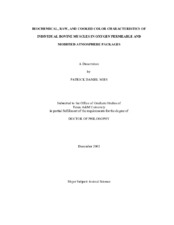| dc.description.abstract | Color stability and cooked muscle color were evaluated in relation to myoglobin content, oxygen consumption rate, pH, lipid oxidation, oxygen penetration depth, metmyoglobin reductase activity, Hunter L*- a*- b*- values, discoloration, and degree of doneness for the M. Infraspinatus (IF), M. Triceps brachii (TB), M. Teres major (TM), M. Rectus femoris (RF), M. Vastus lateralis (VL), M. Semimembranosus (SM),
M. Biceps femoris (BF), M. Semitendinosus (ST), M. Gluteus medius (GM), as well as the M. Psoas major (PM), and M. Longissimus lumborum (LL). Steaks from these muscles were segmented into a low oxygen dark, low oxygen light, high oxygen, and PVC overwrap packaging environment for six days of retail display. There were no major differences in pH, oxygen consumption rate, or myoglobin reductase acitivity between shelf-life days and packaging environments for the muscles used in the study. The VL, TB, ST, SM, and the GM had higher levels of lipid oxidation in the later days of shelf-life storage and were higher (P < 0.05) in high oxygen packaging compared to the other three treatments. Oxygen penetration depth was greater (P < 0.05) over all storage days for the high oxygen treatment in the TB and LL as compared to the other treatments. Hunter CIE a* and b* values significantly decreased across all muscles for the high oxygen and PVC treatments. Discoloration increased significantly as storage days increased in the high oxygen and PVC treatments for the TB, SM, VL, BF, IF, GM, PM, and TM. Degree of doneness was higher (P < 0.05) for the PM, TB, and SM muscles in a high oxygen atmosphere as compared to the low oxygen light and low oxygen dark treatments. Aerobic reducing ability tended to decrease as retail shelf-life day increased. A high oxygen environment increased rancidity, oxygen penetration depth, redness values, and degree of doneness (P < 0.05) when compared to a low oxygen light and low oxygen dark modified atmosphere package. | en |


